Send an Earlier Year Update using Basic PAYE Tools with other software
Updated 28 May 2021
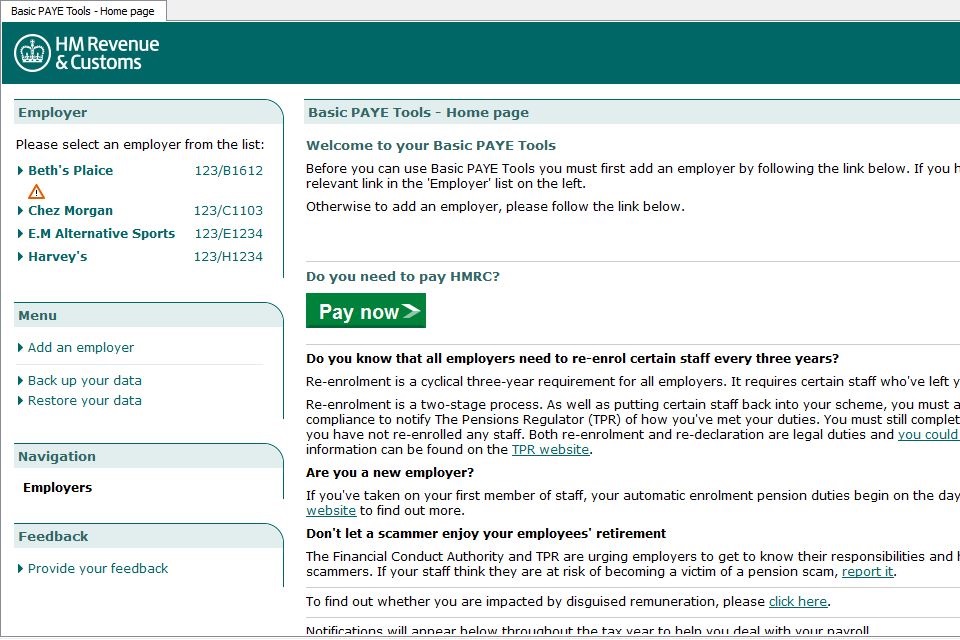
Image showing Basic PAYE Tools - Home page
From April 2021, if you need to make a correction to an amount submitted in Real Time for a closed year, you will need to use the Full Payment Submission process (FPS). Only use an Earlier Year Update (EYU) for the tax years 2019 to 2020 or before.
Overview
This is the Basic Pay As You Earn (PAYE) Tools guide for making an Earlier Year Update (EYU). Use the Basic PAYE Tools (BPT) to complete and submit an EYU if your payroll software does not have this facility.
The screenshots in this guide are the main ones you鈥檒l need to know about. We have not included all the screens as there are some that most employers will not use because they apply to more unusual circumstances.
Due to continuing improvements the screens in this BPT may look slightly different to those shown within this guide.
Important
You need to submit an EYU for any employee that needs payroll data for the previous tax year corrected.
If you use commercial software to run your payroll and send your Full Payment Summary (FPS) in real time, you can still use the BPT to send an EYU to HMRC, the number of employee submissions you can send is not limited.
Getting started
So that you can use the BPT to send an EYU you must have:
- downloaded and installed the software if you:
- do not have the software already, read Download Basic PAYE Tools
- already have BPT, you need to select the update available from 28 March 2020 - check that your computer is connected to the internet, open the BPT and accept the prompt to take the update
- set up the employer
To help you do this, read First time users: Download and install Basic PAYE Tools. This will show you how to set up and install the software and set up the employer.
Find out if you should create multiple submissions
We recommend that you complete the full process separately for each employee requiring a change.
Step 1: Select the correct employer
If you鈥檝e added more than 1 employer to the BPT, you鈥檒l need to select the correct employer.
From the 鈥榟ome screen鈥�, select the correct employer from the list of employers at the top left of your screen.
In the following example, 鈥楬arveys鈥� has been selected.

This will take you to the 鈥楨mployer details鈥� screen.
Check that you have the correct tax year selected.
For example, if you are creating an EYU for the 2019 to 2020 tax year, make sure you select 鈥楾ax year: 2019-20鈥� as shown.
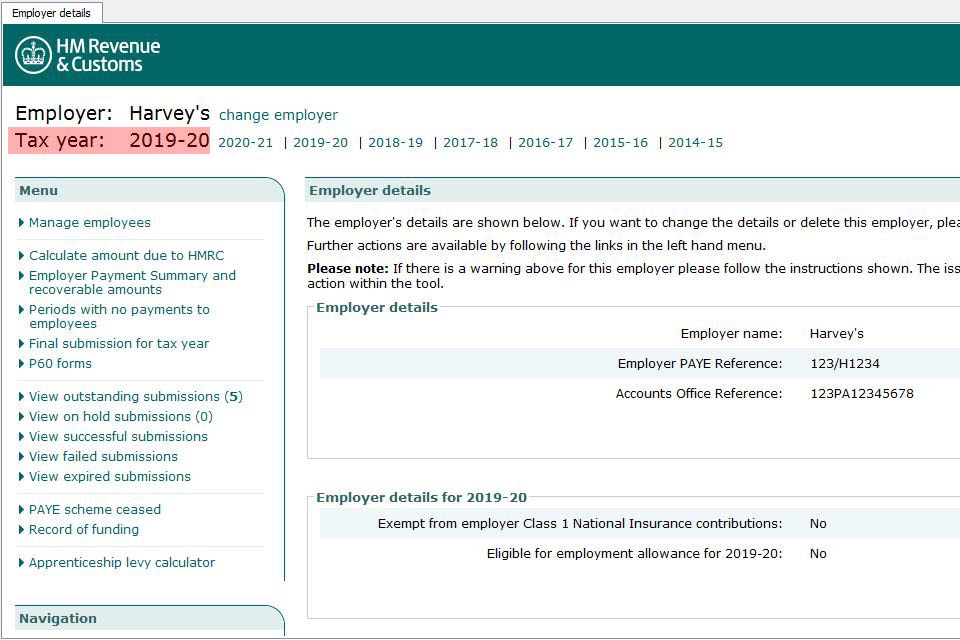
Step 2: Add details about your employee:
To set up the employee for whom you want to create an EYU, you鈥檒l need the following mandatory information:
- full name
- gender
- date of birth
- address
You鈥檒l also need the payroll records for this employee. Select the 鈥楳anage employees鈥� link from the Menu.
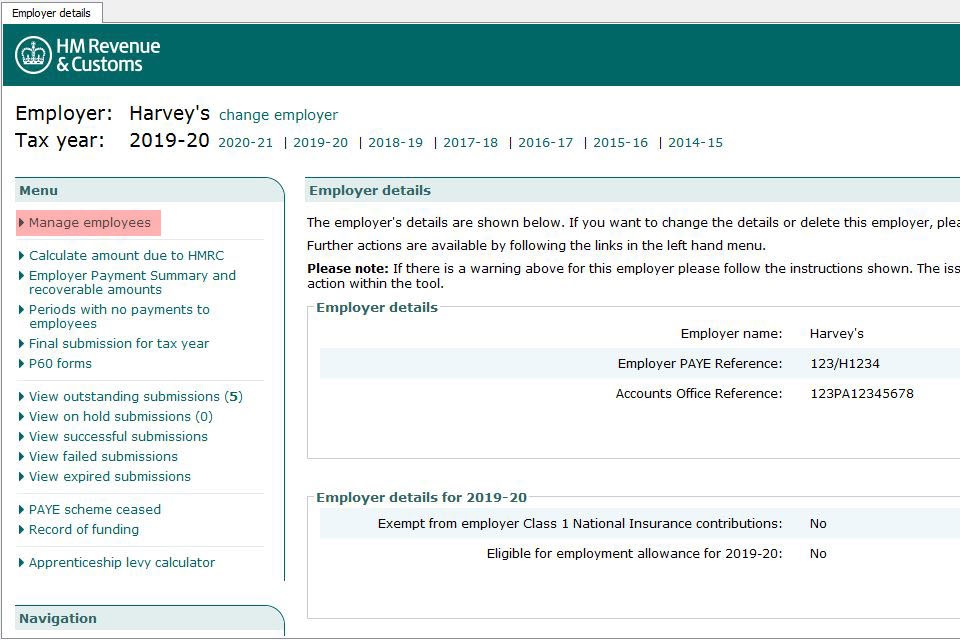
Select 鈥楢dd an employee鈥� from the Menu.
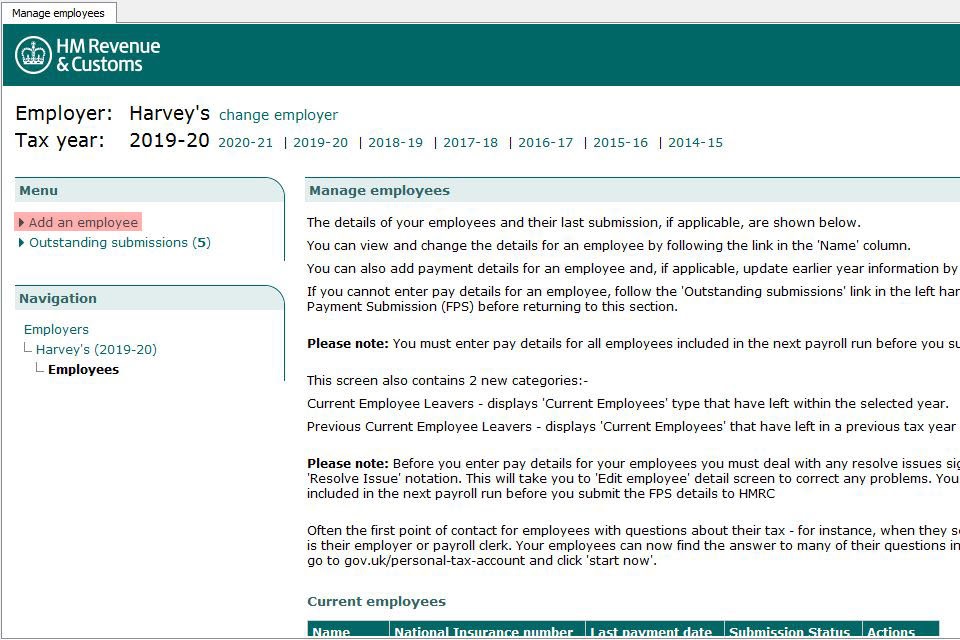
The next screen requires you to select from 4 options.
As you鈥檙e only using the EYU functionality of the BPT, you must select 鈥楨arlier Year Update only鈥� then select 鈥楴ext鈥�.
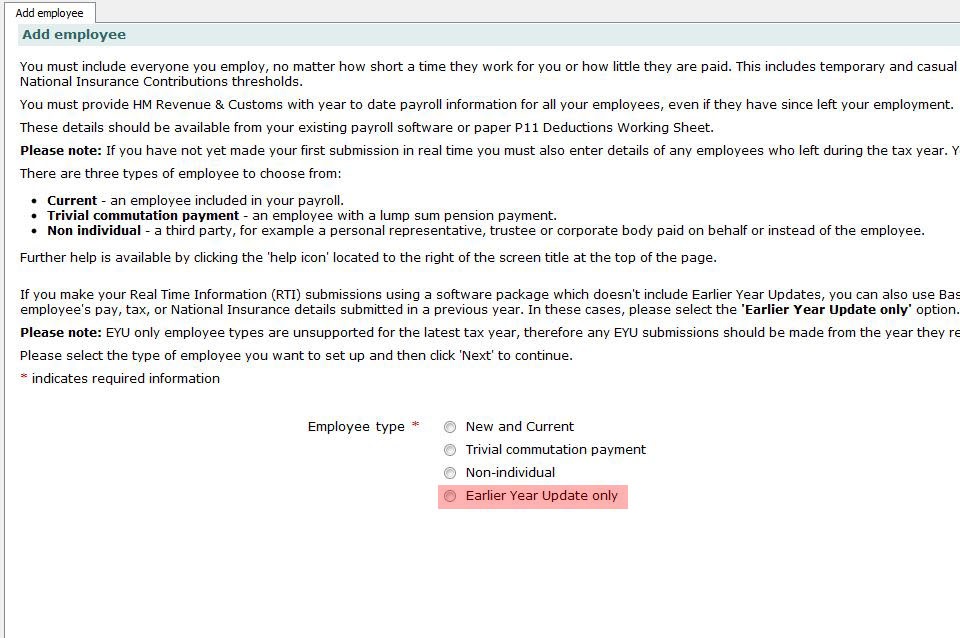
Enter the required information into the blank boxes on the screen that follows, scrolling down as you go, using the onscreen prompts for guidance.
Once all the relevant blank boxes are filled, select 鈥楴ext鈥� to continue.
Important
If your employee has been allocated a payroll ID, works number or employee number, which has been registered with HMRC you must enter it here. Failure to do so could result in a duplicate employment record being created for this employee. Otherwise leave this field blank.
From the 鈥楨mployee details鈥� screen, select 鈥楨arlier Year Update鈥� from the menu.
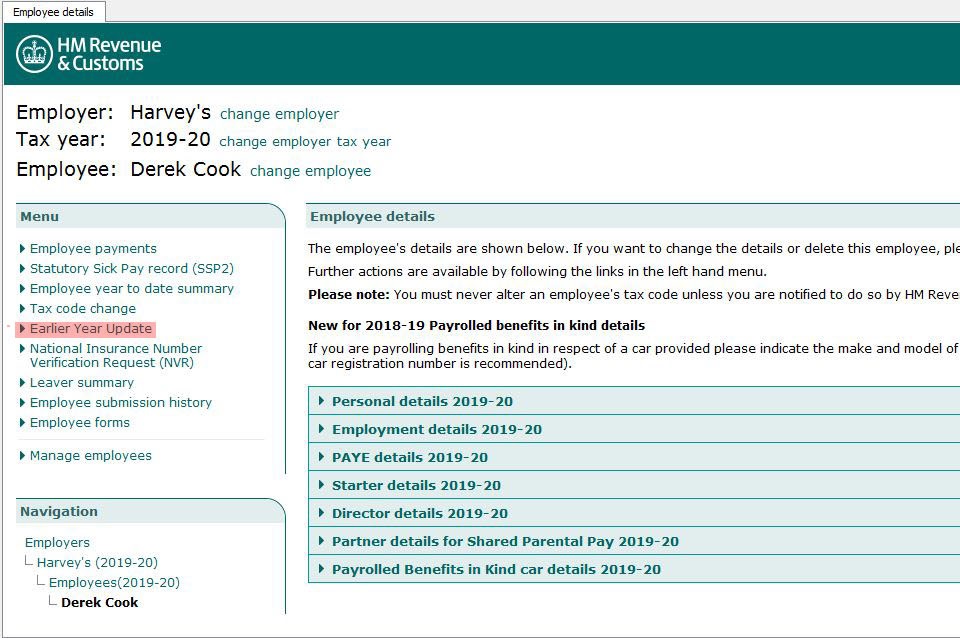
Read the guidance on the next screen and then select 鈥楢dd an Earlier Year Update鈥� to continue.
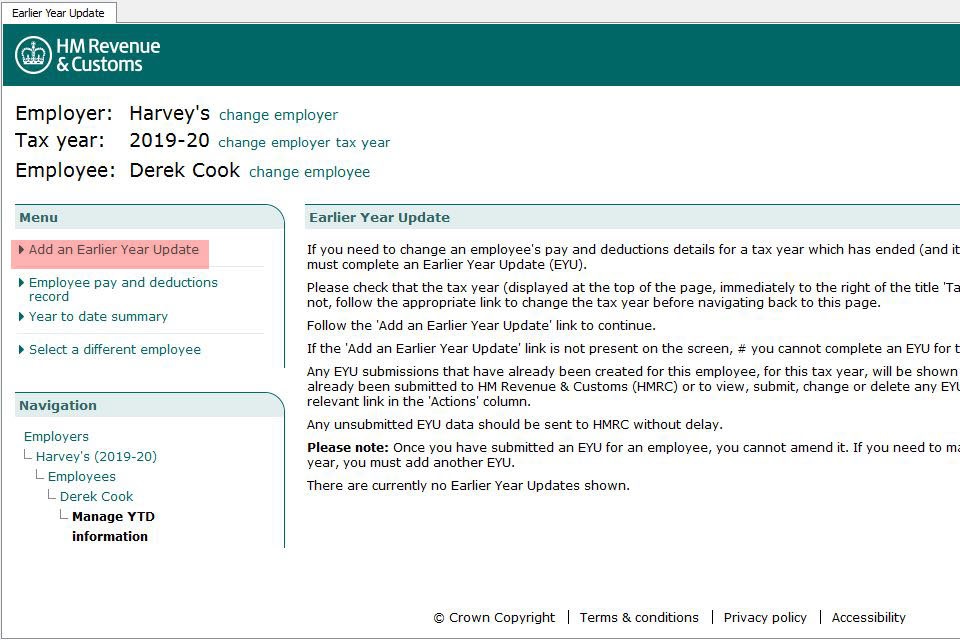
Enter the previously submitted information
This screen is for you to enter the details that were previously submitted to HMRC, on the last FPS for the year which you need to correct. These are referred to as the 鈥楶reviously submitted amount鈥�.
You must complete the 2 mandatory fields:
- tax code
- the basis the code was operated
Then, you only need to complete boxes where a change to the amounts is required.
Tax code details
In the 鈥楾ax details鈥� box, enter the tax code that was reported on the last FPS for the previous year, then enter the basis the code was operated for that tax year.
If you have year-end payroll information applicable for the previous year, but it has not been sent to HMRC on an FPS, you should only complete the tax code and the week 1 month 1 basis, but leave all other boxes blank.
National Insurance category letters
In the boxes labelled 鈥楴ational Insurance details鈥� enter the National Insurance category letter and amounts of earnings liable to National Insurance. For example, earnings at the lower earnings limit, that were previously submitted to HMRC, if they now need amending.
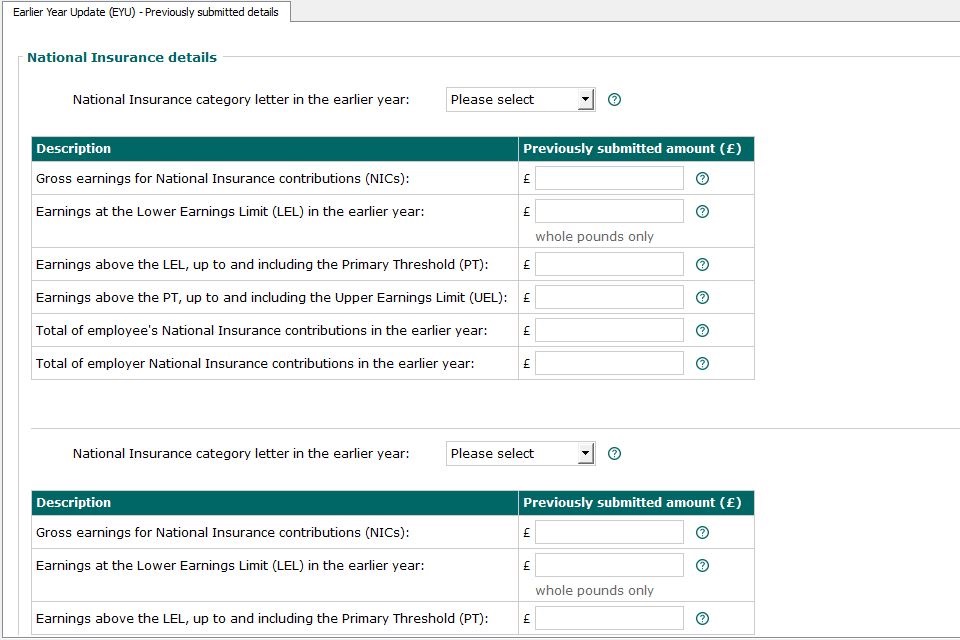
Statutory payments and student loans
Enter details previously reported of any:
- statutory payments
- student or post graduate loan deductions
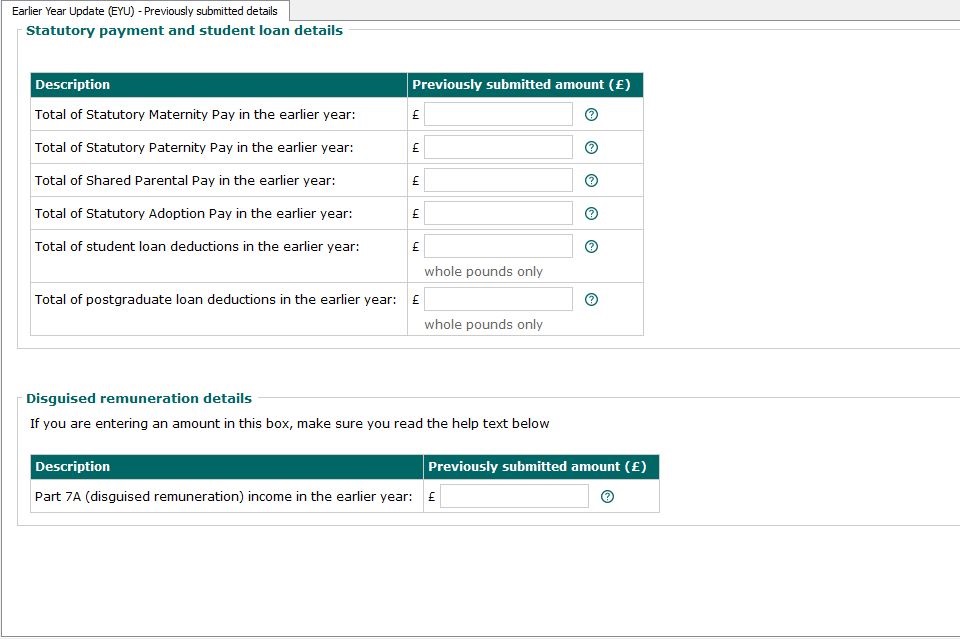
When you鈥檝e completed all relevant boxes on this screen, select 鈥楴ext鈥� to continue.
Enter the correct information
You鈥檒l now see the screen 鈥楨arlier Year Update - Correction details鈥�.
The purpose of this screen is for you to enter the correct details that should have been reported to HMRC.
Example
If you submitted a year to date figure of 拢20,000 for pay on your last FPS for the 2019 to 2020 tax year but realised this should have been 拢21,000, you should have shown 拢20,000 in the previously submitted amount and the 拢21,000 in the correct amount . BPT will then report the difference of the two figures on the EYU submission.
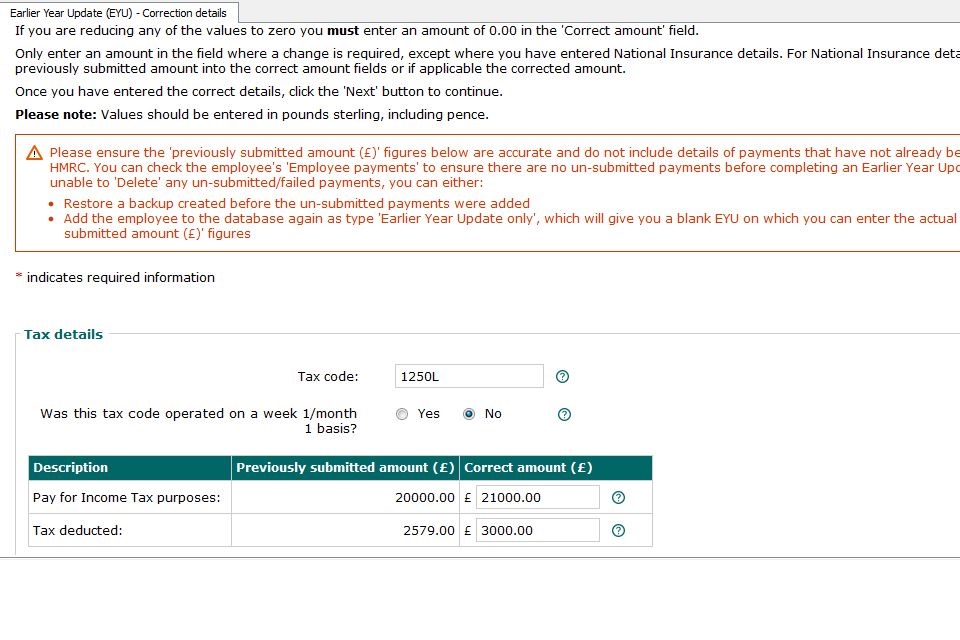
Important
In the example above you can see that different amounts are shown in the 鈥楶reviously submitted amount鈥� and the 鈥楥orrect amount鈥� boxes. You must enter the full amounts in the 鈥楥orrect amount鈥� column, do not enter the difference between the previously submitted figure and the correct figure.
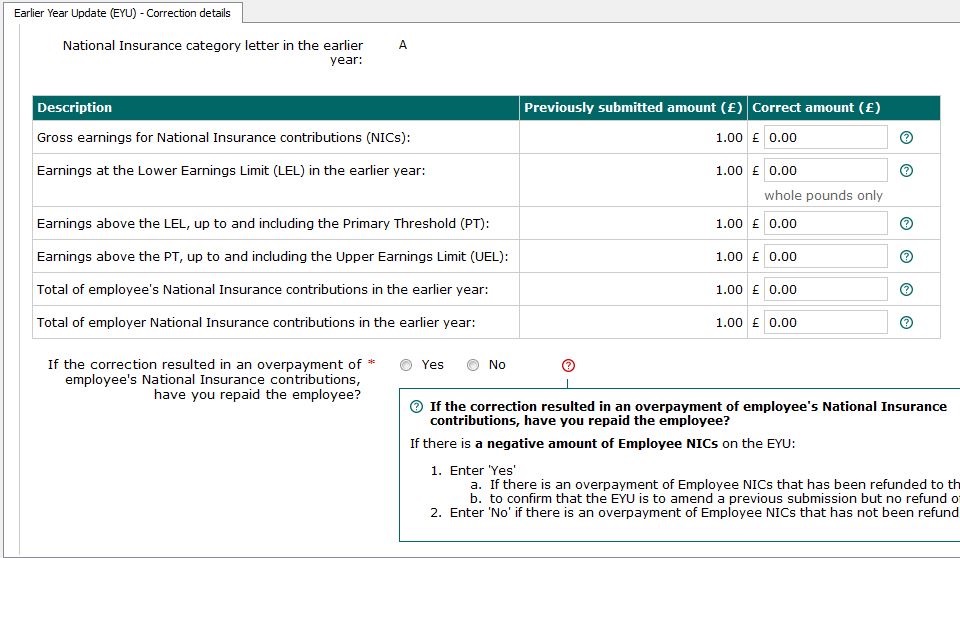
When completing the National Insurance contribution figures in the screen shown above, if there鈥檚 a negative amount of employee National Insurance contributions on the EYU enter 鈥榊es鈥� where either:
- there鈥檚 an overpayment of employee National Insurance contributions that鈥檚 been refunded to the employee
- you wish to confirm the EYU is to amend a previous submission, but no refund of employee National Insurance contributions is due
Enter 鈥楴o鈥� if there鈥檚 an overpayment of employee National Insurance contributions that has not been refunded to the employee.
Select 鈥楴ext鈥� to move to the next screen.
Review Earlier Year Update (EYU)
The next screen will show the differences between the amounts you previously submitted to HMRC and the correct amounts.
The 鈥榙ifferences鈥� are the figures that will to be sent to HMRC on the EYU.
Make sure you have fully reviewed this screen, check the differences between the previous and corrected figures are what you expect.
This data will form the submission that is sent to HMRC. Select 鈥楴ext鈥� to move to the next screen.
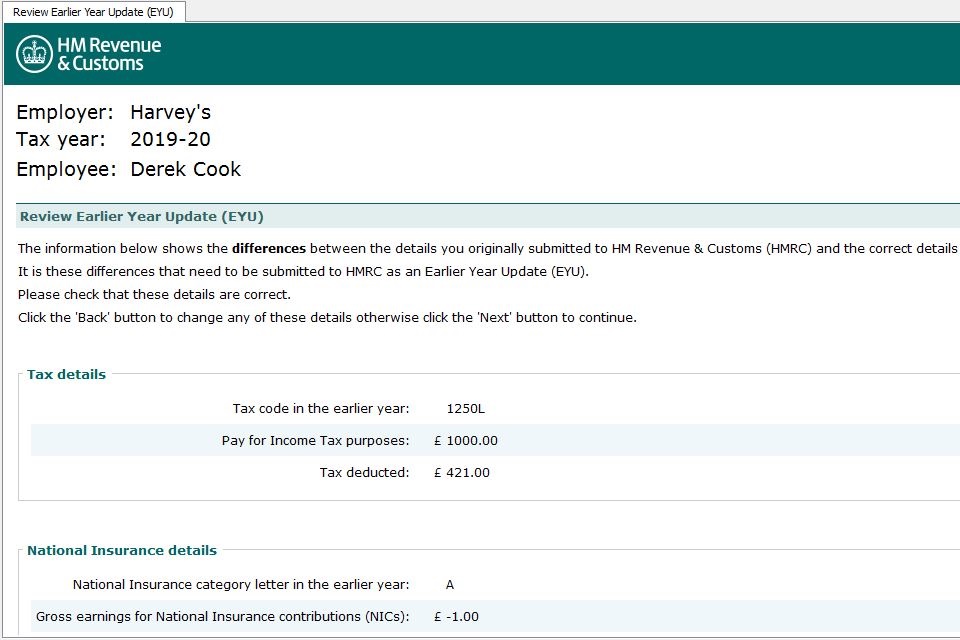
Find out what happens if you have made a mistake
If you have not yet submitted the EYU you can do either of the following:
- change the 鈥榗orrect amount鈥� details on the EYU
- delete the EYU and start again
To do this you should select the relevant employee from the menu, then select 鈥楨arlier Year Update鈥� from the menu. From the EYU unsubmitted submissions select change as shown in the screen and amend the amounts as necessary.
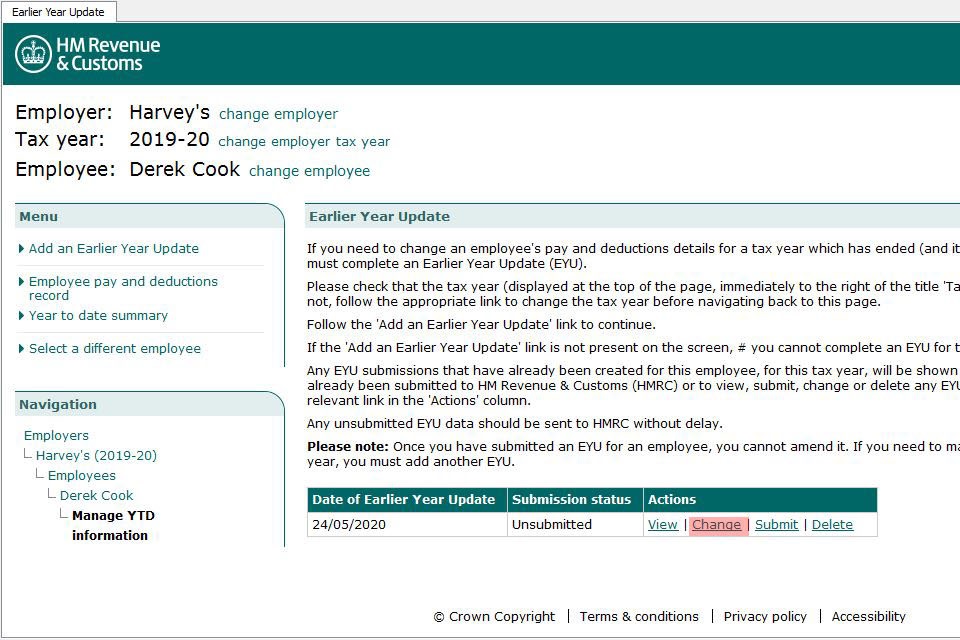
Important
Once you have submitted an EYU for an employee, you cannot amend it. If you need to make further changes for this employee for the same tax year, you must create another EYU.
Find out if you can send another EYU for the same employee
If you need to make a further adjustment for the same employee, you will need to send another EYU using the steps above. The amounts shown on the first EYU in the 鈥楥orrect amount鈥� column need to be entered on the second EYU in the 鈥楶reviously submitted amount鈥� column.
Example
If you have previously submitted an EYU to amend a year end pay figure of 拢10,000 to 拢12,000 the difference 拢2,000 would be submitted on the first EYU.
If you then realise the final pay figure should have been 拢11,000 you should generate a further EYU using 鈥楶reviously submitted amount鈥� of 拢12,000 and 拢11,000 as the 鈥楥orrect amount鈥�.
Step 3: Send the EYU
You have now created the EYU ready to be sent to HMRC.
Remember
You can create an EYU for other employees by repeating Step 2 above, but you may prefer to send the one you鈥檝e created before starting with another employee.
When you鈥檝e finished creating the EYU you should send the submission to HMRC.
Select the correct employer from employer list on the 鈥楬ome Screen鈥�. This will take you to the 鈥楨mployer details screen鈥�.
Select the 鈥榁iew Outstanding submissions鈥� link from the menu.
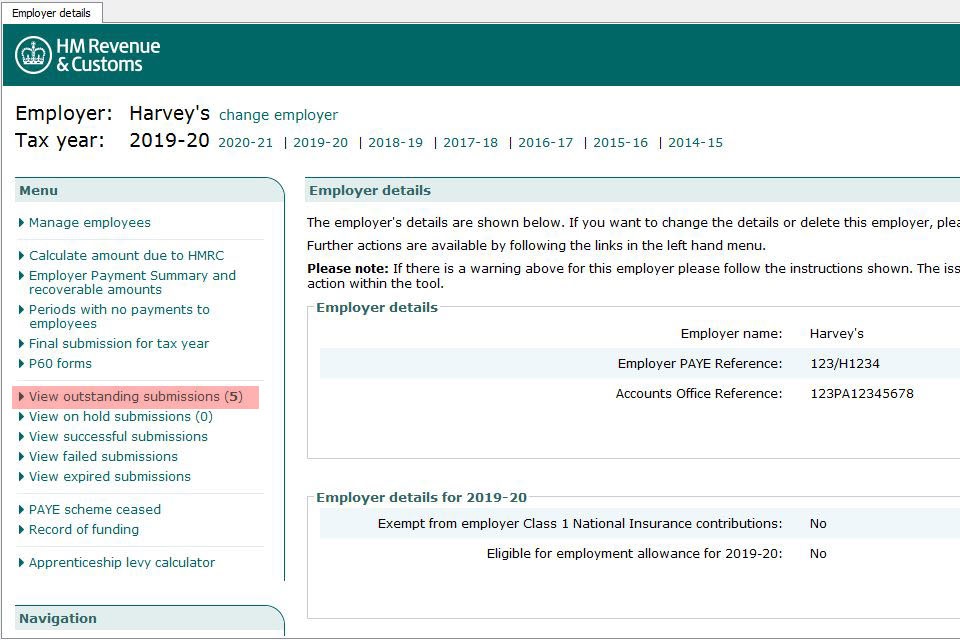
Here you can see there is one outstanding submission which is the EYU for Harvey Morgan.
Select 鈥楽end all outstanding submissions鈥�.
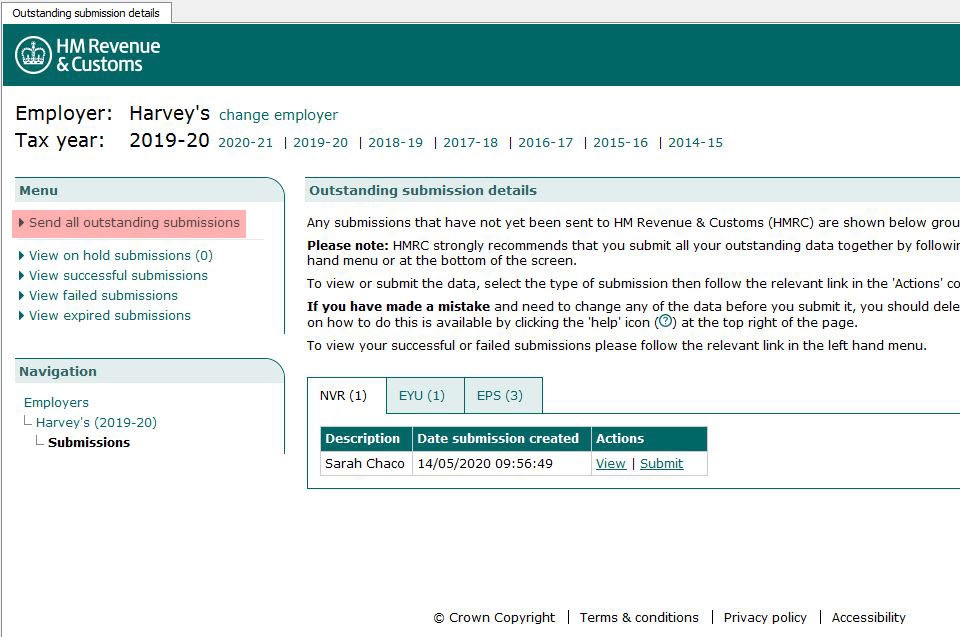
Read the information on the next screen then select 鈥楴ext鈥�.
Enter your Government Gateway 鈥楿ser ID鈥� and 鈥楶assword鈥� in the blank boxes for online submission, and select 鈥楴ext鈥�.
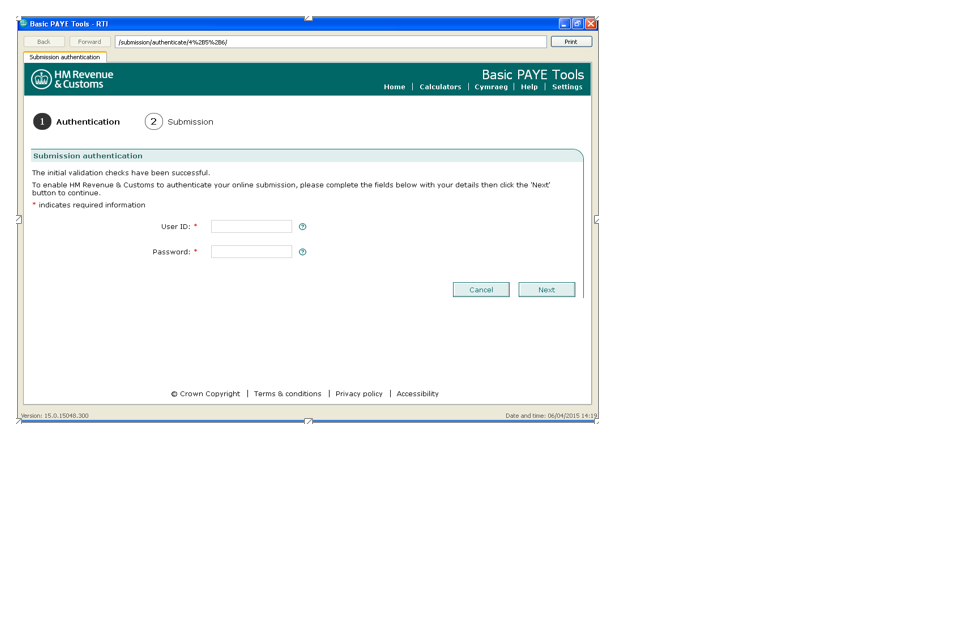
You should receive the following screen showing your submission status.
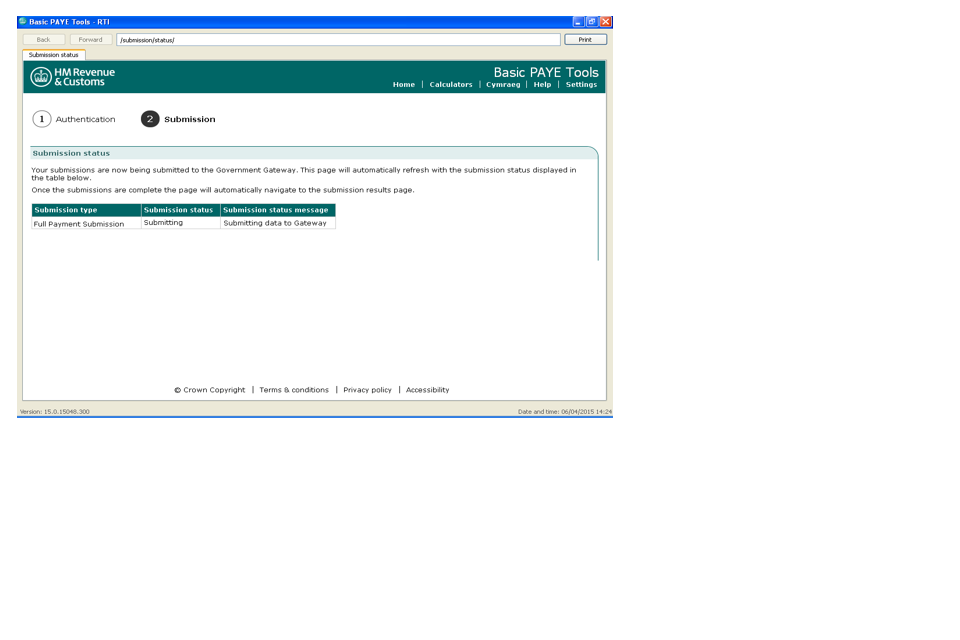
Finally you will receive a screen showing your submission results including a unique reference number for your submission.
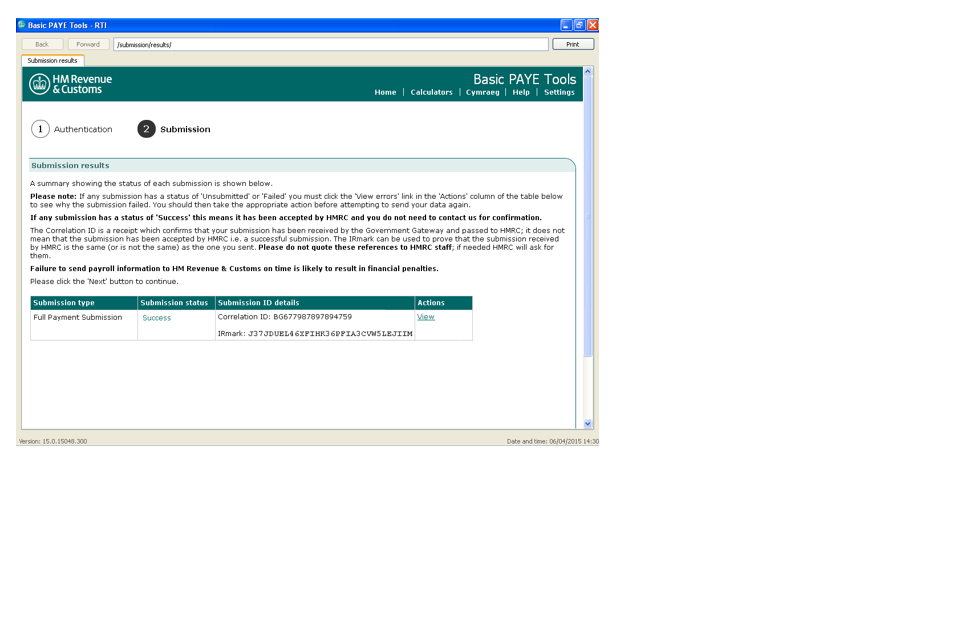
Important
Print any EYU submissions and keep with your payroll records, as a prompt if there are further queries on this employee鈥檚 record.
Step 4: Basic PAYE Tools error codes
We are aware that some BPT users have received error messages when trying to submit an EYU. These messages mean that your submission has not been successfully received by HMRC. The following table gives the error message you may see as well as a description of what you have to do to correct the submission.
| Error message | What you need to do |
|---|---|
| Accounts Office reference or Employer PAYE reference is incorrect | The employer reference and/or Accounts Office reference is incorrect. Check both of them against paperwork from HMRC and amend the incorrect one. For help in doing this refer to All users: using Basic PAYE Tools for real time reporting and work through the 鈥楩inding your way round the Basic PAYE Tools鈥� and 鈥楨mployer overview鈥� sections until you select 鈥楥hange employer details鈥�. |
| This submission cannot be accepted as the pre-defined date for the previous tax year has not yet passed | If you were trying to send an EYU for the 2017 to 2018 tax year, you cannot send an EYU for the 2017 to 2018 tax year until 20 April 2018. Wait until 20 April 2018 then send the EYU. |
| This submission cannot be accepted as it does not fall within the eligible filing period | If you were trying to send an EYU for the 2012 to 2013 tax year, you cannot submit any Real Time Information (RTI) submissions for the 2012 to 2013 tax year unless you were one of the small number of employers who took part in the RTI pilot during the tax years 2012 to 2013 or 2013 to 2014. You must send amended forms P35 and P14. You cannot do this using BPT. The software that you used to run your payroll in the 2012 to 2013 tax year may allow you to do this, otherwise you can use the online forms which are part of HMRC鈥檚 PAYE Online service. |
| - Error code: 7900 - The [ECON] is mandatory if any [NILETTER] is one of 鈥楧鈥�, 鈥楨鈥�, 鈥業鈥�, 鈥楰鈥�, 鈥楲鈥�, 鈥楴鈥�, 鈥極鈥� - [ECON] is mandatory if any [NILETTER] is one of 鈥楧鈥�, 鈥楨鈥�, 鈥業鈥�, 鈥楰鈥�, 鈥楲鈥�, 鈥楴鈥�, 鈥極鈥� - Diagnostic Message: Assertion failure: |
This EYU cannot be sent to HMRC as the employee has a contracted-out NIC letter (D, E, I, K, L, N or O) but you have not provided the Employer Contracted-Out Number (ECON). Background: - an ECON is a reference number allocated to an employer who operates, or is part of a group of companies that operate, a contracted-out pension scheme for their employees - an employee can only be on a contracted-out NIC letter (D, E, L, I, K, N or O) if you the employer have a contracted out pension scheme that the employee is a member of - if you have a contracted-out pension scheme then you will have an ECON Action required: You need to either: - Add the ECON to the Employer details. For help in doing this refer to All users: using Basic PAYE Tools for real time reporting and work through the 鈥楩inding your way round the Basic PAYE Tools鈥� and 鈥楨mployer overview鈥� sections until you select 鈥楥hange employer details鈥�. The ECON is shown on the contracting-out certificate issued by HMRC previously issued by Inland Revenue or Department of Social Security when an employer elects to be contracted- out. If you are unable to find your ECON contact the HMRC Contracted-out pensions helpline. OR If you do not have an ECON: you will need to telephone HMRC鈥檚 Employer Helpline on 0300 200 3200 and advise them you are receiving error code 7900 and that you do not have an ECON. |
